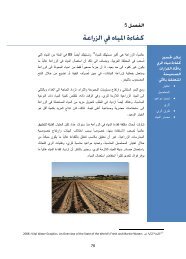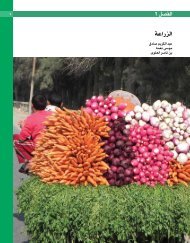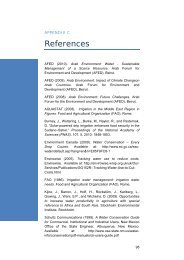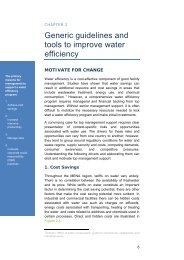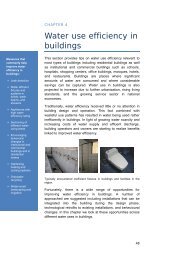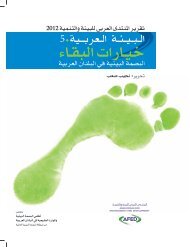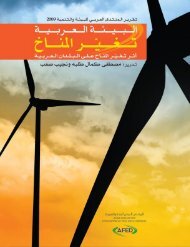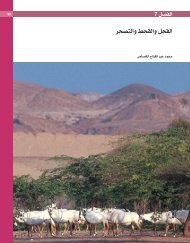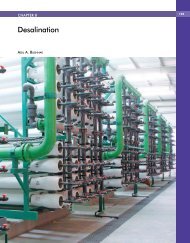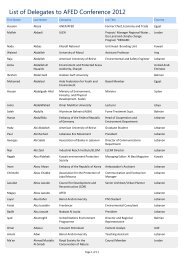Impact of Climate Change on Arab Countries - (IPCC) - Working ...
Impact of Climate Change on Arab Countries - (IPCC) - Working ...
Impact of Climate Change on Arab Countries - (IPCC) - Working ...
You also want an ePaper? Increase the reach of your titles
YUMPU automatically turns print PDFs into web optimized ePapers that Google loves.
ARAB ENVIRONMENT: CLIMATE CHANGE 71<br />
refers to changes in processes, practices, or structures<br />
to moderate or <str<strong>on</strong>g>of</str<strong>on</strong>g>fset potential damages or<br />
to take advantage <str<strong>on</strong>g>of</str<strong>on</strong>g> opportunities associated<br />
with changes in climate. It involves adjustments<br />
to reduce the vulnerability <str<strong>on</strong>g>of</str<strong>on</strong>g> communities,<br />
regi<strong>on</strong>s, or activities to climatic change and variability<br />
(<strong>IPCC</strong>, 2001a).<br />
The high vulnerability <str<strong>on</strong>g>of</str<strong>on</strong>g> the agricultural sector<br />
in developing countries should place it at the top<br />
<str<strong>on</strong>g>of</str<strong>on</strong>g> priority lists <str<strong>on</strong>g>of</str<strong>on</strong>g> adaptati<strong>on</strong> plans. Although climate<br />
change is projected to have serious impacts<br />
<strong>on</strong> the agricultural sector in the <strong>Arab</strong> world, <strong>on</strong>ly<br />
modest efforts and steps are currently being taken<br />
in the areas <str<strong>on</strong>g>of</str<strong>on</strong>g> scientific research, mitigati<strong>on</strong> and<br />
adaptati<strong>on</strong>.<br />
Agriculture has historically shown high levels <str<strong>on</strong>g>of</str<strong>on</strong>g><br />
adaptability to climate variati<strong>on</strong>s. For cropping<br />
systems there are many potential ways to alter<br />
management to deal with projected climatic and<br />
atmospheric changes (Challinor et al., 2007).<br />
These adaptati<strong>on</strong>s include:<br />
a) Altering inputs such as varieties, species, fertilizer,<br />
and amounts and timing <str<strong>on</strong>g>of</str<strong>on</strong>g> irrigati<strong>on</strong><br />
and other water management practices;<br />
b) Wider use <str<strong>on</strong>g>of</str<strong>on</strong>g> simple technologies;<br />
c) Water management to prevent waterlogging,<br />
erosi<strong>on</strong> and nutrient leaching in areas with<br />
rainfall increases;<br />
d) Altering the timing or locati<strong>on</strong> <str<strong>on</strong>g>of</str<strong>on</strong>g> cropping<br />
activities;<br />
e) Diversifying income by integrating other<br />
farming activities such as livestock raising;<br />
f) Improving the effectiveness <str<strong>on</strong>g>of</str<strong>on</strong>g> pest, disease<br />
and weed management practices; and<br />
g) Using seas<strong>on</strong>al climate forecasting to reduce<br />
producti<strong>on</strong> risk.<br />
Many opti<strong>on</strong>s for policy-based adaptati<strong>on</strong> to climate<br />
change have been identified for agriculture,<br />
forests and fisheries (Easterling et al., 2004).<br />
These can either involve adaptati<strong>on</strong> activities<br />
such as developing infrastructure or building the<br />
capacity to adapt in the broader user community<br />
and instituti<strong>on</strong>s, <str<strong>on</strong>g>of</str<strong>on</strong>g>ten by changing the decisi<strong>on</strong><br />
making envir<strong>on</strong>ment under which managementlevel,<br />
adaptati<strong>on</strong> activities occur. Designing and<br />
applying nati<strong>on</strong>al adaptati<strong>on</strong> strategies for the<br />
agriculture sector faces a group <str<strong>on</strong>g>of</str<strong>on</strong>g> barriers,<br />
including limitati<strong>on</strong>s <str<strong>on</strong>g>of</str<strong>on</strong>g> the existing scientific<br />
base, policy percepti<strong>on</strong>s under current c<strong>on</strong>diti<strong>on</strong>s<br />
and pressures, poor adaptive capacity <str<strong>on</strong>g>of</str<strong>on</strong>g> rural<br />
communities, lack <str<strong>on</strong>g>of</str<strong>on</strong>g> financial support, and the<br />
absence <str<strong>on</strong>g>of</str<strong>on</strong>g> an appropriate instituti<strong>on</strong>al framework.<br />
Medany et al. (2007) c<strong>on</strong>clude that designing an<br />
adaptati<strong>on</strong> strategy for the agriculture sector<br />
should c<strong>on</strong>sider the simple and low cost adaptati<strong>on</strong><br />
measures that may be inspired from traditi<strong>on</strong>al<br />
knowledge to meet local c<strong>on</strong>diti<strong>on</strong>s and to<br />
be compatible with sustainable development<br />
requirements. It is not preferable to use imported<br />
soluti<strong>on</strong>s based <strong>on</strong> high levels <str<strong>on</strong>g>of</str<strong>on</strong>g> technology and<br />
high initial costs. Moreover, technology and<br />
knowledge transfer activities are encouraged to<br />
support adaptati<strong>on</strong> strategies. Addressing climate<br />
change mitigati<strong>on</strong> and adaptati<strong>on</strong> in development<br />
strategies means strengthening these strategies<br />
and increasing their efficiency and durability.<br />
Medany et al. (2007) recommend the following<br />
to enhance the planning <str<strong>on</strong>g>of</str<strong>on</strong>g> mitigati<strong>on</strong> and adaptati<strong>on</strong><br />
strategies for the agricultural sector under<br />
Egyptian c<strong>on</strong>diti<strong>on</strong>s:<br />
• Improving the scientific capacity should be<br />
am<strong>on</strong>g the top priorities <str<strong>on</strong>g>of</str<strong>on</strong>g> development planning.<br />
• Political and financial adopti<strong>on</strong> <str<strong>on</strong>g>of</str<strong>on</strong>g> adaptati<strong>on</strong><br />
strategies.<br />
• The bottom-up approach <str<strong>on</strong>g>of</str<strong>on</strong>g> planning and<br />
implementing adaptati<strong>on</strong> and mitigati<strong>on</strong><br />
strategies could be more efficient.<br />
• Developing community-based measures by<br />
stakeholders’ involvement in adaptati<strong>on</strong> planning,<br />
and improving the adaptive capacity <str<strong>on</strong>g>of</str<strong>on</strong>g><br />
the different human sectors.<br />
• Increasing the public awareness and improving<br />
the c<strong>on</strong>cept <str<strong>on</strong>g>of</str<strong>on</strong>g> climate and its relati<strong>on</strong> to envir<strong>on</strong>mental<br />
and human systems.<br />
• Improving adaptive capacity <str<strong>on</strong>g>of</str<strong>on</strong>g> the community<br />
should be based <strong>on</strong> a clear scientific message,<br />
and enjoy str<strong>on</strong>g governmental support.<br />
Attaher et al. (2009) studied the farmers’ percepti<strong>on</strong><br />
for adaptati<strong>on</strong> planning in Nile Delta<br />
regi<strong>on</strong>, and c<strong>on</strong>cluded that farmers have a real<br />
initiative to act positively to reduce the impact <str<strong>on</strong>g>of</str<strong>on</strong>g><br />
climate change. Moreover, although community<br />
engagement in adaptati<strong>on</strong> planning is very<br />
important, the scientific evaluati<strong>on</strong> should be<br />
taken into account to set a more practical list <str<strong>on</strong>g>of</str<strong>on</strong>g><br />
adaptati<strong>on</strong> measures.



